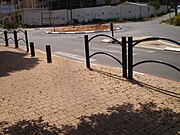Tag:highway=footway
| Description |
|---|
| A path mainly or exclusively for pedestrians. |
| Rendering in OSM Carto |

|
| Group: highways |
| Used on these elements |
| Implies |
| Useful combination |
|
| Status: de facto |
| Tools for this tag |
|
The tag highway=footway is used for mapping minor pathways which are used mainly or exclusively by pedestrians.
If you are mapping footpaths in the UK (specifically England and Wales) see UK public rights of way.
- For wider pedestrianised streets, typically, lined with shops or commercial buildings use the tag highway=pedestrian.
- For multi-use or unspecified paths and trails used by a variety of non-motorised traffic the tag highway=path may be better suited.
- These can be further classified with sac_scale=*, trail_visibility=*, surface=* and access=*.
- For pathways designated for cyclists only, consider instead using the tag highway=cycleway.
- Where a pathway is designated for pedestrians but is also allowed for bicycles you can use highway=footway and bicycle=yes.
- Dirt roads for mostly agricultural, forestry, etc. uses should be tagged as highway=track.
- For tagging
![Wikipedia [W]](/w/images/2/24/Wikipedia-16px.png) sidewalks that span on one or both sides of a road. In the United Kingdom these may be known as 'pavements' or 'footways'. For the best practice there are a couple of options to follow: either add the tags sidewalk=left;right;both or sidewalk=separate on the feature describing the road, or create a new way marking the sidewalk that is running parallel to the road then describe it using highway=footway – see below for more details.
sidewalks that span on one or both sides of a road. In the United Kingdom these may be known as 'pavements' or 'footways'. For the best practice there are a couple of options to follow: either add the tags sidewalk=left;right;both or sidewalk=separate on the feature describing the road, or create a new way marking the sidewalk that is running parallel to the road then describe it using highway=footway – see below for more details.
How to map
Linear ways
To map a footway nothing else than a simple way is required. Add the highway=footway tag to it and add a name=* if appropriate.
Add access=* restriction tags if appropriate. See default access restrictions.
If the footway is associated with a road, then add the footway=sidewalk tag.
The way footway=* or highway=footway must join with another kind of way. For motivation, see Beginners Guide step 5, or Editing Standards and Conventions.
| Example photos | Example tracking | Referring tag | Comment |
|---|---|---|---|
| Reference S letter. +highway=footway (defines the way). |
In case of footway no is along the highway=*, but you submit into an area, for example in a park, use tag highway=pedestrian, which we refer for the appropriate information. | ||
| Reference for the sidewalk S letter. +highway=footway (defines the way). |
Reference B letter
| ||
| Reference for the tags, S – C – C1 – C2 letters. +highway=footway (defines the way). |
Areas
There is no clear consensus on this topic – see the talk page for more information.
There are two main approaches to mapping the area of a highway=footway, and which to use is dependent upon the context of the area you're mapping. If you are mapping the area of a footway simply to describe the area it covers (e.g., rather than using width=*, perhaps because the width is variable) then it is recommended to use the area:highway=footway tag.
If, however, you are mapping the area of a footway because this provides non-linear routing —for example, large sidewalk areas— then you can map the area as highway=footway and area=yes. This tagging scheme is similar to the well-established highway=pedestrian + area=yes tagging scheme used when mapping pedestrian areas such as plazas and squares. However, there is a clear distinction between highway=footway and highway=pedestrian, and so we should not conflate these two types of highways.
When mapping a highway area, the area should be connected via a node to at least one way. Some mappers chose to continue the way through the area, to enable routers to pick the most straightforward route through the area, but this way should still share nodes with the area (e.g., in the places where it enters and exists the area).
Tags used in combination
- footway=* – type of a footway, e.g.:
- surface=*
- lit=*
- access=* tags, e.g.:
- bicycle=*
- name=* – if it has a name
- informal=yes – additive tag to indicate a informal/unofficial footway
See also
- highway=path – A generic or multi-use path open to non-motorised traffic
- highway=pedestrian – Road or area mainly or exclusively for pedestrians
- area:highway=footway – An area representation of linear footways
- sidewalk=* – Indicates the presence or absence of a sidewalk (pavement/footway) on a road
- Path controversy gives explanation how this is different from / similar to highway=path
- UK public rights of way
- Guidelines for pedestrian navigation
| ||||||||||||||||||||||||||||||





